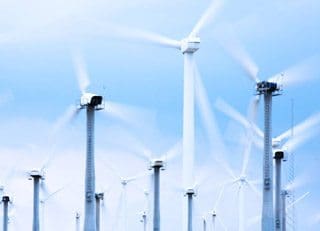
Galloping climate change and dwindling supplies of fossil fuels are driving ever-greater interest in renewable energy. As a result, wind energy is booming worldwide. Not since the heyday of the American farm windmill has wind energy grown at such a dramatic pace. Today there are more than 100,000 commercial-scale wind turbines and untold thousands of small wind turbines spinning out more than 160 terawatt- hours (billion kilowatt-hours) of electricity annually, from the steppes of Mongolia to the shores of the North Sea.
While attention in North America until now has been on the giant wind farms springing up across the breadth of the continent like giant mushrooms, there’s another, often overlooked side to wind energy: distributed generation, or putting wind power where people live and work.
Distributed wind generation is booming, too, mostly in Europe, where the use of wind turbines in or near cities and villages is commonplace. But a growing number of small wind turbines are also finding homes on sailboats, at remote cabins, or at new homesteads at the end of the utility’s lines or even off the grid entirely. The focus of the original edition of Wind Energy Basics was small wind turbines. Consequently, this article of Wind Energy expands the number of wind turbine size classes over those used in the earlier edition.
Relative Size
In wind energy, size, especially rotor diameter matters. More specifically, the area swept by the wind turbine’s rotor or the area of the wind it intercepts – is the single most important aspect of a wind turbine.
Wind turbines range in size from Southwest Windpower’s 200-watt Air Breeze, a micro turbine, which uses a rotor only 1.2 meters (2.8 ft) in diameter, to Enercon’s 6,000 kW giant, with a rotor spanning 126 meters (400 ft). There is no ironclad rule on what constitutes a small or large wind turbine. Size designations are somewhat arbitrary. Clearly the Air Breeze is small, and Enercon’s 6-megawatt turbine is not. Wind turbines of any size can be used in distributed applications either singly or in small groups.
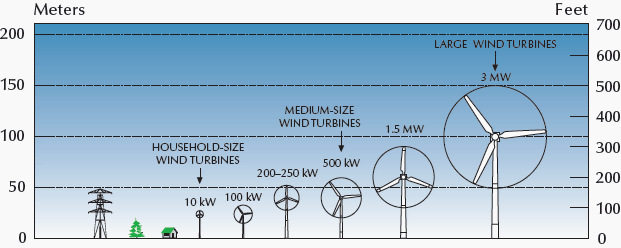
Wind Turbine Size Classes
Some wind turbines are so small you can pick them up in your hands. Mongolian nomads carry these micro turbines on horseback from one encampment to the next. Other wind turbines are so large you can see them from commercial airliners as you streak across the sky (see table 0-1, Wind turbine size classes).
Though we often use the power rating of a wind turbine as shorthand for its size, this can be very misleading.
While their contributions may be small in absolute terms, small wind turbines make a big difference in the daily lives of people in remote areas around the globe.
Small wind turbines may produce only a few tens of kilowatt-hours of electricity per month, but this electricity goes much farther and provides as much, if not more, value to those who depend upon it as the generation of large wind turbines in areas served by utility power.
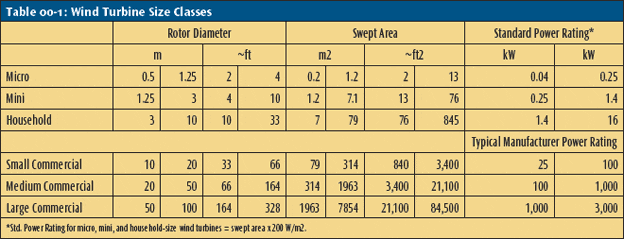
Typically, small wind turbines encompass machines producing anywhere from a few watts to 10–20 kW. Rotors reaching 10 meters (30 ft) in diameter drive wind turbines at the upper end of this range. Small wind turbines can be subdivided further into micro wind turbines— the smallest of small turbines—mini wind turbines, and household-size wind turbines. In Wind Energy Basics we classify micro turbines as those from 0.5 to 1.25 meters (2–4 ft) in diameter.
These machines include Southwest Windpower’s 200-watt Air Breeze as well as Ampair’s model 300. Both use rotors 1.2 meters in diameter and intercept about 1 square meter of the wind stream (see figure 0-1, Micro wind turbine).
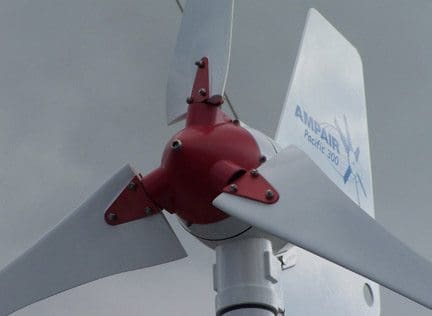
Mini wind turbines are slightly larger and span the range between the micro turbines and the bigger household-size machines. They vary in diameter from 1.25 to 3 meters (4–10 ft). Popular turbines in this category include Southwest Windpower’s Whisper 100 as well as Bergey Windpower’s XL.1. The Whisper 100 uses a 2.1-meter (7 ft) rotor and intercepts 3.6 square meters (m2) while the bigger XL.1 uses a 2.5-meter (8 ft) rotor that sweeps 4.9 m2.
Thus, these two turbines are four to five times bigger than the Air Breeze or Ampair 300 (see figure 0-2, Mini wind turbine).
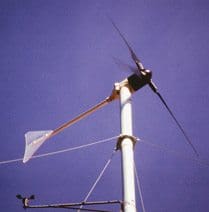
Household-size wind turbines (a translation of the Danish term hustandmølle) are the largest of the small wind turbine family.
As you would expect, wind turbines in this class span a wide spectrum. They include models as small as Southwest Windpower’s Skystream with a rotor 3.7 meters (12 ft) in diameter, as well as the Bergey Excel that uses a rotor 7 meters (23 ft) in diameter and weighs in at nearly 500 kilograms (1,000 lbs).
The Skystream sweeps 10 m2, whereas the Bergey sweeps nearly 4 times more area than the Skystream and 40 times more than the Air Breeze (see figure 0-3, Householdsize wind turbine). Small commercial turbines, such as Entegrity’s EW50, are intended for farms, schools, and small businesses. They range in diameter from 10 to 20 meters (30–70 ft) and sweep up to 300 m2. Entegrity’s 50 kW turbine, patterned after hundreds of similar turbines used in California during the 1980s, intercepts 175 m2.
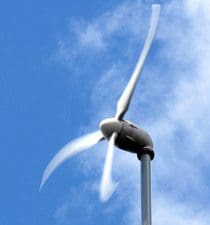
Turbines in this class are capable of producing from 50 kW to 100 kW (see figure 0-4, Small commercial scale wind turbine).
Medium-size wind turbines are those used for commercial applications such as farms, factories, businesses, and small wind farms. They can range from 20 to 50 meters (70–160 ft) in diameter and sweep as much as 3,000 m2. Turbines in this class can be rated from 100 kW to more than 1,000 kW (see figure 0-5, Medium-size, commercial-scale wind turbine).
Large commercial-scale turbines are the machines found in modern wind power plants. Though huge on a human scale, they can be found singly or in small clusters in or near cities throughout Europe. For a comparison of the scale, consider the Vestas V80, a wind turbine variously rated from 1,800 kW to 2,000 kW, depending upon where it is used in the world. This wind turbine sweeps more than 5,000 m2; that is, the V80 is 5,000 times bigger than the Air Breeze or the Ampair 300 (see figure 0-6, Large wind turbine).
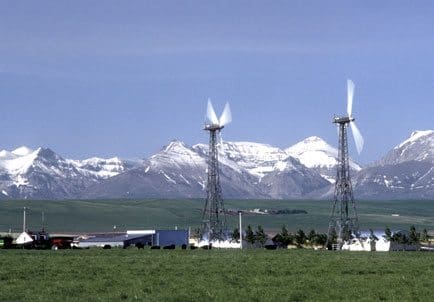










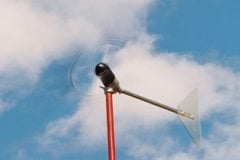


Thanks